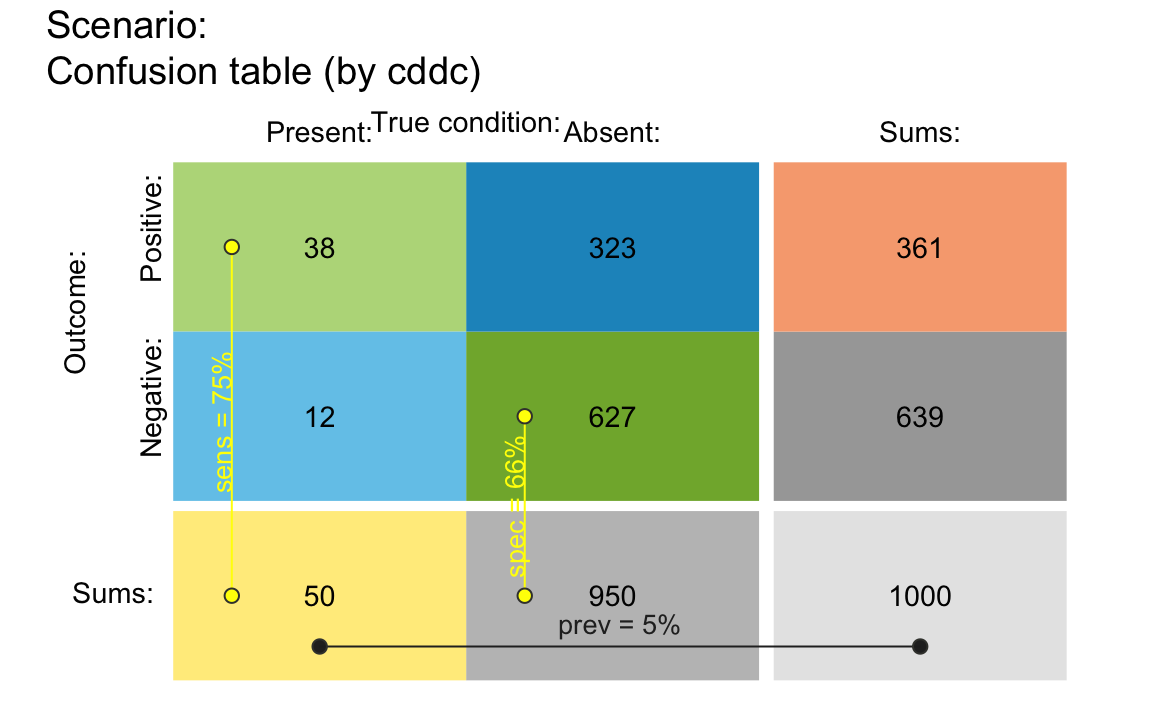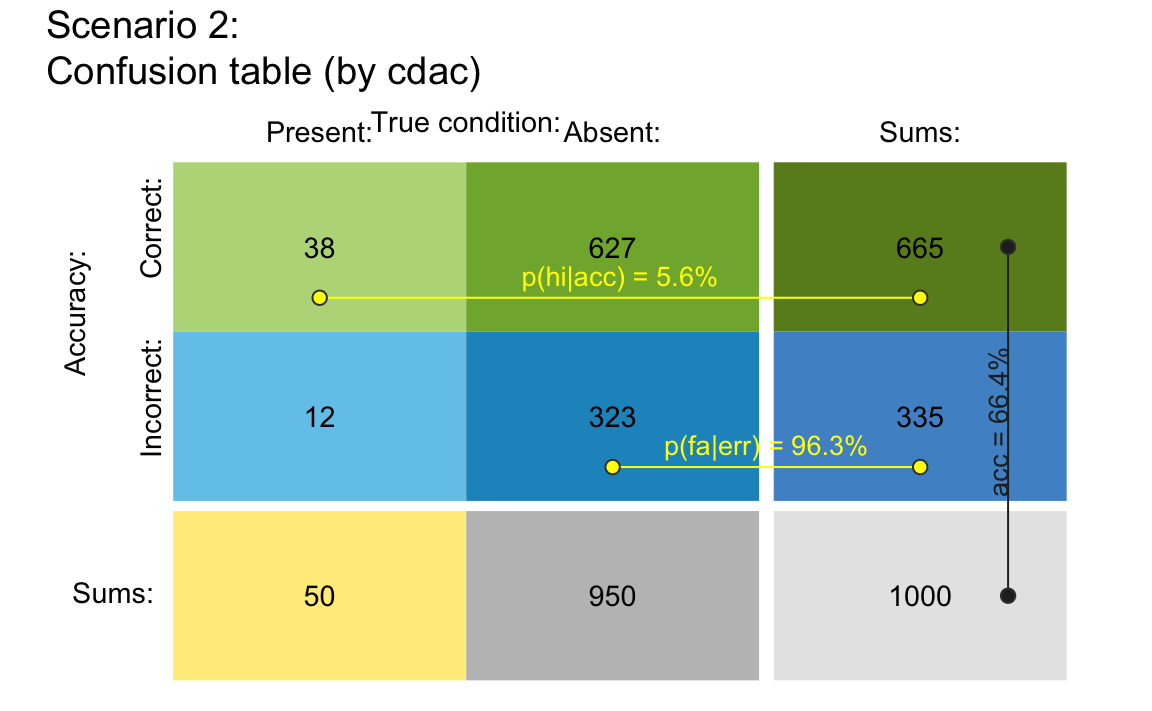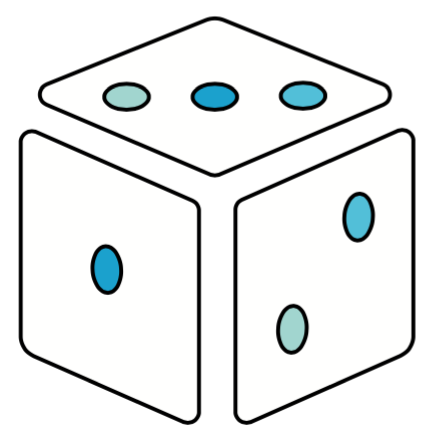
Confusion Matrix and Metrics
Hansjörg Neth, SPDS, uni.kn
2021 03 31
Source:vignettes/C_confusion_matrix.Rmd
C_confusion_matrix.RmdBehold the aptly named “confusion matrix”:
| Condition | ||||
|---|---|---|---|---|
| Decision | present (TRUE): |
absent (FALSE): |
Sum: | (b) by decision: |
positive (TRUE): |
hi |
fa |
dec_pos |
PPV =
hi/dec_pos
|
negative (FALSE): |
mi |
cr |
dec_neg |
NPV =
cr/dec_neg
|
| Sum: | cond_true |
cond_false |
N |
prev =
cond_true/N
|
| (a) by condition |
sens =
hi/cond_true
|
spec =
cr/cond_false
|
ppod =
dec_pos/N
|
acc =
dec_cor/N =
(hi+cr)/N
|
Most people, including medical experts and social scientists,
struggle to understand the implications of this matrix. This is no
surprise when considering explanations like the corresponding article on
Wikipedia,
which squeezes more than a dozen metrics out of four essential
frequencies (hi, mi, fa, and
cr). While each particular metric is quite simple, their
abundance and inter-dependence can be overwhelming.
Fortunately, the key representational structure can also be understood as a 2x2 matrix (aka. 2-by-2 contingency table), which is actually quite simple, and rather straightforward in its implications. In the following, we identify the most important aspects and some key measures that a risk-literate person should know (see Neth et al., 2021, for a more detailed account).
Basics
Condensed to its core, the 2x2 matrix cross-tabulates (or “confuses”) two binary dimensions and classifies each individual case into one of four possible categories that result from combining the two binary variables (e.g., the condition and decision of each case) with each other. This sounds more complicated than it is:
| Condition | ||
|---|---|---|
| Decision | present (TRUE): |
absent (FALSE): |
positive (TRUE): |
hi |
fa |
negative (FALSE): |
mi |
cr |
Fortunately, this table is not so confusing any more: It shows four frequency counts (or “joint” frequencies) that result from cross-tabulating two binary dimensions. And, perhaps surprisingly, all other metrics of interest in various contexts and domains follow from this simple core in a straightforward way. In the following, we illustrate how the other metrics can be constructed from the four essential frequencies.
Adopting two perspectives on a population
Essentially, the confusion matrix views a population of
N individuals in different ways by adopting different
perspectives. “Adopting a perspective” means that we can distinguish
between individuals on the basis of some criterion. The two primary
criteria used here are:
(a) each individual’s condition, which can either be present
(TRUE) or absent (FALSE), and
(b) each individual’s decision, which can either be
positive (TRUE) or negative
(FALSE).
Numerically, the adoption of each of these two perspectives splits the population into two subgroups.1 Applying two different splits of a population into two subgroups results in cases, which form the core of the confusion matrix:
-
hirepresents hits (or true positives): condition present (TRUE) & decision positive (TRUE). -
mirepresents misses (or false negatives): condition present (TRUE) & decision negative (FALSE). -
farepresents false alarms (or false positives): condition absent (FALSE) & decision positive (TRUE). -
crrepresents correct rejections (or true negatives): condition absent (FALSE) & decision negative (FALSE).
Importantly, all frequencies required to understand and compute
various metrics are combinations of these four frequencies — which is
why we refer to them as the four essential frequencies (see the
vignette on Data formats). For
instance, adding up the columns and rows of the matrix yields the
frequencies of the two subgroups that result from adopting our two
perspectives on the population N (or
splitting N into subgroups by applying two binary
criteria):
(a) by condition (cd) (corresponding to the two columns
of the confusion matrix):
(b) by decision (dc) (corresponding to the two rows of
the confusion matrix):
To reflect these two perspectives in the confusion matrix, we only need to add the sums of columns (i.e., by condition) and rows (by decision):
| Condition | ||||
|---|---|---|---|---|
| Decision | present (TRUE): |
absent (FALSE): |
Sum: | |
positive (TRUE): |
hi |
fa |
dec_pos |
|
negative (FALSE): |
mi |
cr |
dec_neg |
|
| Sum: | cond_true |
cond_false |
N |
An third perspective is provided by considering the diagonals of the 2x2 matrix. In many semantic domains, the diagonals denote the accuracy of the classification, or the correspondence between dimensions (see below).
Example
To view a 2x2 matrix (or confusion table) in riskyr,
we can use the plot_tab() function (i.e., plot an existing
scenario as type = "tab"):
## (1) Plot table from basic input parameters: -----
plot_tab(prev = .05, sens = .75, spec = .66, N = 1000,
p_lbl = "def") # show condition probabilies (by default)
Example of a 2x2 confusion table in riskyr.
Accuracy as a third perspective
A third way of grouping the four essential frequencies results from asking the question: Which of the four essential frequencies are correct decisions and which are erroneous decisions? Crucially, this question about decision accuracy can neither be answered by only considering each individual’s condition (i.e., the columns of the matrix), nor can it be answered by only considering each individual’s decision (i.e., the rows of the matrix). Instead, answering the question about accuracy requires that the other dimensions have been determined and then considering the correspondence between condition and decision. Checking the correspondence between rows and columns for the four essential frequencies yields an important insight: The confusion matrix contains two types of correct decisions and two types of errors:
-
A decision is correct, when it corresponds to the condition. This is the case for two cells in (or the “" diagonal of) the confusion matrix:
-
hi: condition present (TRUE) & decision positive (TRUE) -
cr: condition absent (FALSE) & decision negative (FALSE)
-
-
A decision is incorrect or erroneous, when it does not correspond to the condition. This also is the case for two cells in (or the “/” diagonal of) the confusion matrix:
-
mi: condition present (TRUE) & decision negative (FALSE) -
fa: condition absent (FALSE) & decision positive (TRUE)
-
Splitting all N individuals into two subgroups of those
with correct vs. those with erroneous decisions yields a third
perspective on the population:
(c) by accuracy (ac) or the correspondence between
decisions and conditions (corresponding to the two diagonals of the
confusion matrix):
Example
Re-arranging the cells of the 2x2 matrix allows illustrating accuracy
as a third perspective (e.g., by specifying the perspective
by = "cdac"):
plot_tab(prev = .05, sens = .75, spec = .66, N = 1000,
by = "cdac", p_split = "h",
p_lbl = "def", title_lbl = "Scenario 2")
#> Argument 'title_lbl' is deprecated. Please use 'main' instead.
Arranging a 2x2 confusion table by condition and by accuracy.
Avoiding common sources of confusion
It may be instructive to point out two possible sources of confusion, so that they can be deliberately avoided:
-
Beware of alternative terms for
miandcr:Misses
miare often called “false negatives” (FN), but are nevertheless cases for which the condition isTRUE(i.e., in thecond_truecolumn of the confusion table).Correct rejections
crare often called “true negatives” (TN), but are nevertheless cases for which the condition isFALSE(i.e., in thecond_falsecolumn of the confusion table).
Thus, the terms “true” and “false” are sometimes ambiguous by
switching their referents. When used to denote the four essential
frequencies (e.g., describing mi as “false negatives” and
cr as “true negatives”) the terms refer to the
correspondence of a decision to the condition, rather than to their
condition. To avoid this source of confusion, we prefer the terms
mi and cr over “false negatives” (FN) and
“true negatives” (TN), respectively, but offer both options as
pre-defined lists of text labels (see txt_org and
txt_TF).
- Beware of alternative terms for
dec_coranddec_err:
Similarly, it may be tempting to refer to instances ofdec_coranddec_erras “true decisions” and “false decisions”. However, this would also invite conceptual confusion, as “true decisions” would includecond_falsecases (cror TN cases) and “false decisions” would includecond_truecases (mior FN cases). Again, we prefer the less ambiguous terms “correct decisions” vs. “erroneous decisions”.
Accuracy metrics
The perspective of accuracy raises an important question: How good is some decision process (e.g., a clinical judgment or some diagnostic test) in capturing the true state of the condition? Different accuracy metrics provide different answers to this question, but share a common goal — measuring decision performance by capturing the correspondence of decisions to conditions in some quantitative fashion.2
While all accuracy metrics quantify the relationship between correct and erroneous decisions, different metrics emphasize different aspects or serve different purposes. We distinguish between specific and general metrics.
A. Specific metrics: Conditional probabilities
The goal of a specific accuracy metric is to quantify some particular
aspect of decision performance. For instance, how accurate is our
decision or diagnostic test in correctly detecting
cond_true cases? How accurate is it in detecting
cond_false cases?
As we are dealing with two types of correct decisions
(hi and cr) and two perspectives (by columns
vs. by rows), we can provide 4 answers to these questions. To obtain a
numeric quantity, we divide the frequency of correct cases (either
hi or cr) by
(a) column sums (cond_true vs. cond_false):
This yields the decision’s sensitivity (sens) and
specificity (spec):
(b) row sums (dec_pos vs. dec_neg): This
yields the decision’s positive predictive value
(PPV) and negative predictive value
(NPV):
B. General metrics: Measures of accuracy
In contrast to these specific metrics, general metrics of accuracy
aim to capture overall performance (i.e., summarize the four essential
frequencies of the confusion matrix) in a single quantity.
riskyr currently computes four general metrics (which
are contained in accu):
1. Overall accuracy acc
Overall accuracy (acc) divides the number of correct
decisions (i.e., all dec_cor cases or the “" diagonal of
the confusion table) by the number N of all decisions (or
individuals for which decisions have been made). Thus,
Accuracy
acc:= Proportion or percentage of cases correctly classified.
Numerically, overall accuracy acc is computed as:
2. Weighted accuracy wacc
Whereas overall accuracy (acc) does not discriminate
between different types of correct and incorrect cases, weighted
accuracy (wacc) allows for taking into account the
importance of errors. Essentially, wacc combines the
sensitivity (sens) and specificity (spec), but
multiplies sens by a weighting parameter w
(ranging from 0 to 1) and spec by its complement
(1 - w):
Weighted accuracy
wacc:= the average of sensitivity (sens) weighted byw, and specificity (spec), weighted by(1 - w).
Three cases can be distinguished, based on the value of the weighting
parameter w:
If
w = .5,sensandspecare weighted equally andwaccbecomes balanced accuracybacc.If
0 <= w < .5,sensis less important thanspec(i.e., instances offaare considered more serious errors than instances ofmi).If
.5 < w <= 1,sensis more important thanspec(i.e., instances ofmiare considered more serious errors than instances offa).
3. Matthews correlation coefficient mcc
The Matthews correlation coefficient (with values ranging from to ) is computed as:
The mcc is a correlation coefficient specifying the
correspondence between the actual and the predicted binary categories. A
value
of
represents chance performance, a value
of
represents perfect performance, and a value
of
indicates complete disagreement between truth and predictions.
See Wikipedia: Matthews correlation coefficient for details.
4. F1 score
For creatures who cannot live with only three general measures of
accuracy, accu also provides the F1 score, which
is the harmonic mean of PPV (aka. precision) and
sens (aka. recall):
See Wikipedia: F1 score for details.
For many more additional scientific metrics that are defined on the basis of a 2x2 matrix, see Section 4. Integration (e.g., Figure 6 and Table 3) of Neth et al. (2021).
References
Neth, H., Gradwohl, N., Streeb, D., Keim, D.A., & Gaissmaier, W. (2021). Perspectives on the 2x2 matrix: Solving semantically distinct problems based on a shared structure of binary contingencies. Frontiers in Psychology, 11, 567817. doi: 10.3389/fpsyg.2020.567817 (Available online)
Phillips, N. D., Neth, H., Woike, J. K., & Gaissmaier, W. (2017). FFTrees: A toolbox to create, visualize, and evaluate fast-and-frugal decision trees. Judgment and Decision Making, 12, 344–368. (Available online: pdf | html | R package )
Links to related Wikipedia articles:
Resources
The following resources and versions are currently available:
| Type: | Version: | URL: |
|---|---|---|
| A. riskyr (R package): | Release version | https://CRAN.R-project.org/package=riskyr |
| Development version | https://github.com/hneth/riskyr/ | |
| B. riskyrApp (R Shiny code): | Online version | https://riskyr.org/ |
| Development version | https://github.com/hneth/riskyrApp/ | |
| C. Online documentation: | Release version | https://hneth.github.io/riskyr/ |
| Development version | https://hneth.github.io/riskyr/dev/ |
Contact
We appreciate your feedback, comments, or questions.
Please report any riskyr-related issues at https://github.com/hneth/riskyr/issues/.
Contact us at contact.riskyr@gmail.com with any comments, questions, or suggestions.
All riskyr vignettes
| Nr. | Vignette | Content |
|---|---|---|
| A. | User guide | Motivation and general instructions |
| B. | Data formats | Data formats: Frequencies and probabilities |
| C. | Confusion matrix | Confusion matrix and accuracy metrics |
| D. | Functional perspectives | Adopting functional perspectives |
| E. | Quick start primer | Quick start primer |

